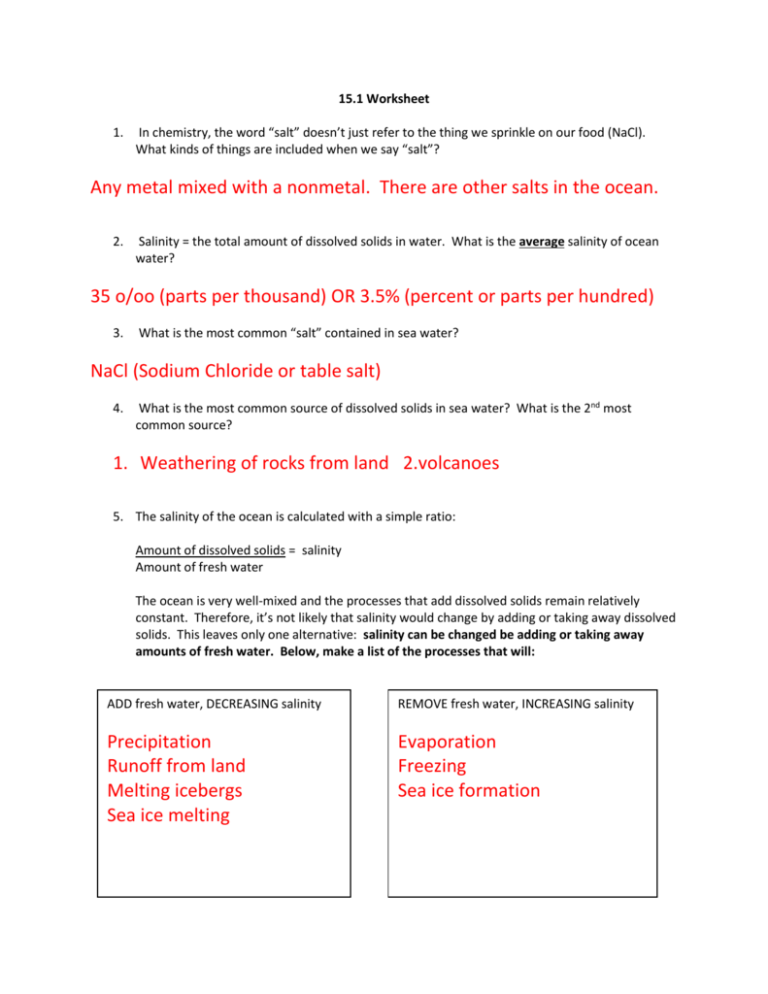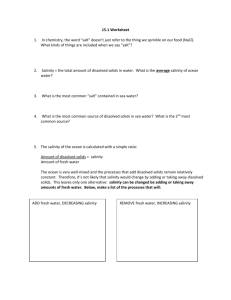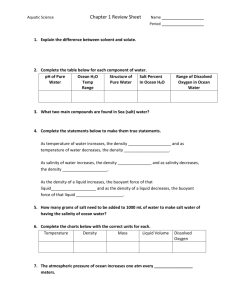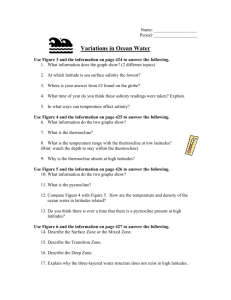Ocean Salinity, Temperature, and Density Worksheet
advertisement

15.1 Worksheet 1. In chemistry, the word “salt” doesn’t just refer to the thing we sprinkle on our food (NaCl). What kinds of things are included when we say “salt”? Any metal mixed with a nonmetal. There are other salts in the ocean. 2. Salinity = the total amount of dissolved solids in water. What is the average salinity of ocean water? 35 o/oo (parts per thousand) OR 3.5% (percent or parts per hundred) 3. What is the most common “salt” contained in sea water? NaCl (Sodium Chloride or table salt) 4. What is the most common source of dissolved solids in sea water? What is the 2nd most common source? 1. Weathering of rocks from land 2.volcanoes 5. The salinity of the ocean is calculated with a simple ratio: Amount of dissolved solids = salinity Amount of fresh water The ocean is very well-mixed and the processes that add dissolved solids remain relatively constant. Therefore, it’s not likely that salinity would change by adding or taking away dissolved solids. This leaves only one alternative: salinity can be changed be adding or taking away amounts of fresh water. Below, make a list of the processes that will: ADD fresh water, DECREASING salinity REMOVE fresh water, INCREASING salinity Precipitation Runoff from land Melting icebergs Sea ice melting Evaporation Freezing Sea ice formation 6. The ocean’s surface waters will change temperature with the amount of solar radiation (sunlight received). As you learned at the beginning of the year, the amount of sunlight the Earth receives varies with latitude. Use the data from figure 3 to fill out the table below and make a summary statement Latitude 60 North Approx. Surface Temp. 30 North 10 C 0C 0 (Equator) 25 C 30 South 10 C 60 South 0C 7. Summarize the relationship between temperature and latitude: As latitude decreases (closer to the equator), temperature increases. The sun can’t reach very far into the ocean. Because of this, the temperature begins to quickly drop as you increase depth in the ocean. This rapid change in temperature with depth is called the thermocline. Why is there no thermocline in the high latitude diagram below? Because the poles receive very little direct sunlight throughout the year. Not enough to even warm surface. 8. Density = mass/volume (or how much stuff is in a given space). Density of sea water will change based upon two factors: a. Temperature. (Liquid) water expands when heated. Based upon this info, fill in the blank below Temperature increase = density ___decreases___ b. Salinity. As you dissolve more solids into the same volume of water, you are putting more “stuff” in the same space. Based upon this info, fill in the blank below Salinity increase = density __increase__ 9. Based changes in salinity and temperature, the density of sea water will vary at different latitudes and depths. This change in density with depth is called the pycnocline. What is the single most important factor affecting density in this graph? ______Temperature. As more sunlight/heat is received, water expands. This makes surface water at low latitudes less dense. ___________________ 10. Why is density in sea water such an important factor? It will determine whether water will float or sink above other layers of water. **Water of different density doesn’t mix easily** 11. Summarize the key differences between the following ocean layers a. Surface zone/Mixed Zone 2% of total water in ocean Extends down from surface to 300-450m Roughly same temp: WARM b. Transition zone Between surface & deep 18% of total water in ocean Temperature begins to drop here Density begins to increase Where the thermocline and pycnocline exist c. Deep zone 80% of ocean water Lowest layer COLD and DENSE No sunlight 12. The diagram below shows a cross-section of the world’s oceans and how they vary by latitude. Why do we ONLY see deep zone water at high latitudes? Because there is no warming of water @ surface. Low amounts of sunlight at high lats. Why do we see a large transition zone between 40N and 40S? Surface waters are heated and deep water is not. Transition zone is in the middle of these layers that don’t want to mix together.









